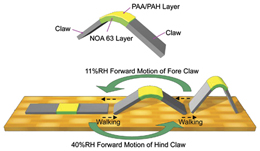材料ナノアーキテクトニクスを目指して機能性層状構造体としてのナノ材料を形成する
Forming Nanomaterials as Layered Functional Structures towards Materials Nanoarchitectonics.
2012年5月18日 NPG Asia Materials 4, e5 (2012) doi:10.1038/am.2012.30
ナノ材料:一層ずつ重ねる

材料の特性は構造に依存する。おそらく、その最もよい例は、グラファイトやグラフェン、カーボンナノチューブの挙動が大きく異なることであろう。ナノテクノロジーの出現とともに、ナノスケール材料を再構成して組織化構造体を作ることがますます重要になってきた。このたび、物質・材料研究機構の有賀克彦主任研究者をはじめとする研究チームが、このテーマについて解説、特にレイヤー・バイ・レイヤー(Layer-by-Layer)技術の汎用性を強調している。この技術は、バルクから分離したシート材料を、ときには別の構成要素を用いて、異なるさまざまな方法で組み立てるというものである。シート材料を基板上に層状に重ねる方法には、静電相互作用のみならず、共有結合や配位結合、水素結合などの利用があり、このほかにもレイヤー・バイ・レイヤー法の実施には、浸漬法やスピンコーティング、スプレー法など実にさまざまな手段がある。そしてそれらすべてが、多種多様な形態、特性、応用(生物医学分野を含む)を持つ構造体の形成を可能にするのだ。
Nanomaterials: One layer at a time
The properties of a material depend on its architecture — this is perhaps best exemplified by the dramatically different behaviours of graphite, graphene and carbon nanotubes. With the advent of nanotechnology, arranging materials into specific, organized structures at the nanoscale has become increasingly important. This issue is discussed here by Katsuhiko Ariga and co-workers, who emphasize the versatility of the layer-by-layer technique. Sheets are first separated from the bulk and assembled differently, sometimes with other components. They can be layered on substrates through electrostatic interactions but also covalent, coordination or hydrogen bonds, and the layer-by-layer procedure can also be carried out in different ways, such as dipping, spin coating or spraying. All of this enables the formation of structures with a wide variety of morphologies, properties and applications, including in the biomedical field.

